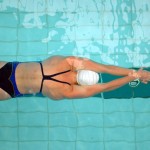 There are many things you can do in a swimming pool to prepare yourself for open water swimming.
There are many things you can do in a swimming pool to prepare yourself for open water swimming.
If you improve your technique you are more likely to swim in a straight line. Anyone planning on open water swimming should first practise straight line swimming in a pool.
Any imperfection of stroke technique, like pulling your arm across the body will send you off course every single stroke. Most swimmers benefit from a faster stroke rate when swimming in open water, just like mountain biking on a rough road. A quick but efficient stroke during open water swimming is essential because you need to be able to adjust your stroke to the conditions, if you’re unable to do this you’ll have a slow laboured stroke.
An average triathlete takes 1.2 seconds to cover 1.0 metre so every metre that is inefficient, you have wasted at least 2.4 seconds going wrong and correcting. During an open water swim triathlon if you deviate you will also bump into other swimmers who are going in a straight line, this will slow you and other swimmers down wasting even more time and energy.
1- Avoid drills that cause you to glide, as this should be avoided when open water swimming. Do not try and slow your stroke down during pool swimming in the belief that this will mimic wearing a wetsuit in open water. Swim with fingers open during the warm up and cool down and at any time you are getting fatigue and your arms are aching or you feel your stroke is slow and laboured.
2 – Swim with your head out of the water polo style during every other work out. Aim to practise this for half of each length for at least 20% of the total distance of the water polo style segment. This is a very time efficient and demanding work out. If you plan to cover 2,000m in training then you need to incorporate a total of 400m, half length sprints then half lengths water polo emphasis. Recover for half the time taken and repeat. Many triathletes slow down to recover during a competition because they failed to practise this during pool swimming training.
3 – At least one session a week swimming in a pool should involve either treading water in the deep end or during the recovery. No standing in the pool or tumble turns or pushing off from each end. Start floating in a star fish shape away from the edge and make sure you u-turn at each end without touching the sides. During open water swimming you will be constantly swimming and there will be no ends to push off or places to stand up during a swim.
Mark Kleanthous has competed in more than 450 triathlons and has competed as an elite and recorded some of the fastest T1 & T2 transition times overall. Mark Kleanthous has competed in triathlons for 30 consecutive seasons and crossed the finish line in more than 450 triathlons including 35 ironman events. He is the author of The Complete Book of Triathlon Training and is a full time sports and nutrition coach. Mark can be contacted via his web site www.ironmate.co.uk
 Subscribe
Subscribe